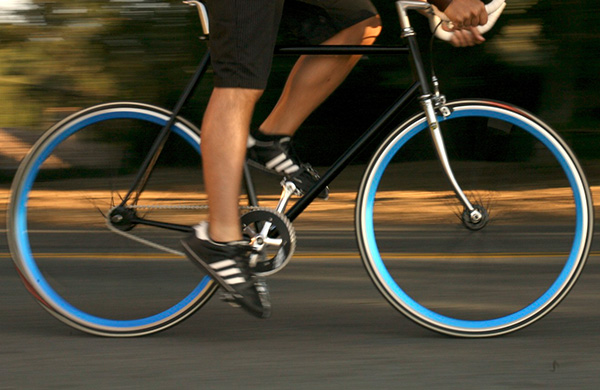If you've jumped into the world of biking, you've likely come across the term "fixie." This is a shortened, catchier word for "fixed-gear bicycles" or "fixed-wheel bicycles." But if you've never ridden one (or don't understand the mechanics of a fixed gear), it can be confusing to know why you should ride a fixie.
To help you figure out if a fixie might be right for you, we spoke with Luis Iñiguez and Lesley Tweedie of Chicago's Kozy's Cyclery and Roscoe Village Bikes, respectively. These two seasoned pros explained some of the benefits and drawbacks of riding fixed-gear bikes.
What is a fixie bike?
With no gears, shifters, or even brakes, fixed-wheel bicycles are bikes at their most basic. Since you can't shift up and down, you're simply pedaling to move the bike. If you want to bike fast, you pedal faster, and vice versa.
Now, if you read that first sentence and said, "no brakes?!" scroll down to "how to brake a fixie" and we'll sort that out.
What is the benefit of a fixed gear bike?
Let's touch on four big reasons why you should ride a fixie:
1. Fixies are the "purest" form of bike out there.
No gears or shifters means a simple, no-nonsense riding style. Pedal forward to go forward; pedal backward to slow down or go in reverse. This engaged riding experience is part of what makes fixies so unique. As Tweedie puts it, fixies help riders "feel at one with the bike" and achieve a better sense of control.
2. It's a great workout
Since riders need to start and stop their momentum without the gradual, easy buildup afforded by a set of gears, pedaling a fixie can quickly turn into a challenging lower-body workout. "It forces you to spin the whole time you're riding," Tweedie explains.
3. For flatland commuters, fixies get you there quickly.
If you plan on using your bike for short trips or commutes in mostly flatland areas, a fixie can be great. Its light weight means that it can build some serious speed—fixies have roots in track racing, after all. "Lots of messengers ride fixed-gears," Tweedie notes, though she stresses the importance of practicing on a fixie before taking it to the street.
4. Fewer parts means there's less to fix.
Since a fixie lacks the moving parts typically found on other bikes, there's naturally less to repair. "It's a low-maintenance type of bike," Iñiguez says. That minimal upkeep is what compels some riders to swear by fixies.
How to ride a fixie
Riding fixed-gear bikes can be both rewarding and practical, though you'll have to get used to being without some of the comforts that normally come standard on road and mountain bikes.
Iñiguez and Tweedie have the same advice for anyone looking to start riding a fixed-gear bike: practice, practice, practice. Getting used to starting and stopping without the comforts of shifting and braking takes time, especially in an urban riding environment. "For city riding, it's definitely something to get used to," Iñiguez says.
How to brake on a fixie
Since there are no brakes on the bike, you're probably wondering how to stop when your fixie is moving along at a brisk speed. You have several options:
- Stop pedaling. You'll say "duh," but this is the first thing to do. The pedals will keep moving, but you'll reduce momentum, which is a start.
- Put pressure (backward) on the pedals. This'll accelerate the reduction in momentum.
- And while purists may be against it...you can install a front-wheel brake on your fixie (just don't tell anybody).
Where can you buy a fixie bike?
Easy! Just go to your local bike shop and ask the technicians to let you try one out before you buy (you'll want to pedal a little before you purchase one). To find bike shops near you, just click the banner below:







